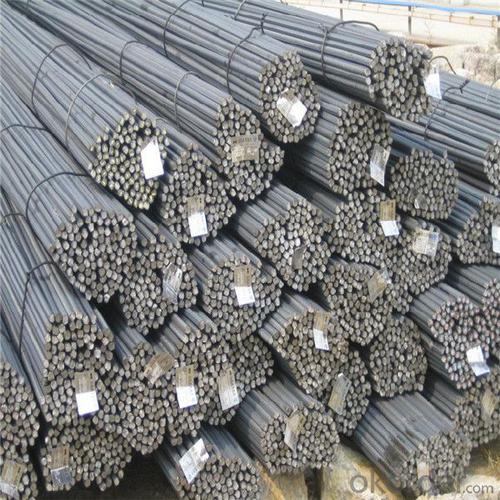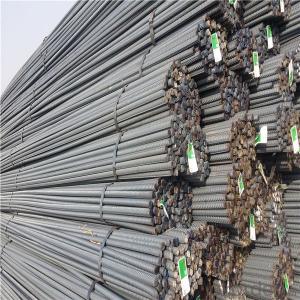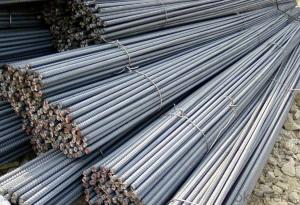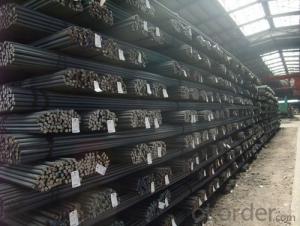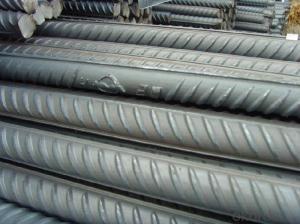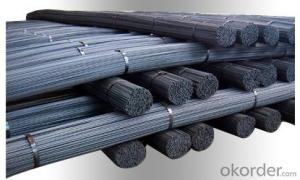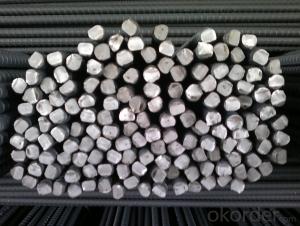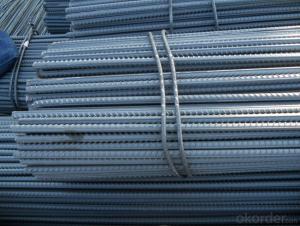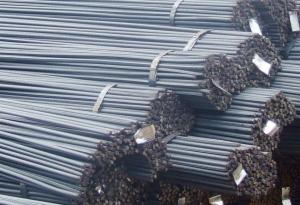Material steel rebar high quality from China
- Loading Port:
- Guangzhou
- Payment Terms:
- TT OR LC
- Min Order Qty:
- 100 m.t.
- Supply Capability:
- 19000 m.t./month
OKorder Service Pledge
OKorder Financial Service
You Might Also Like
Specification
Rebar has ridges that bind it mechanically to the concrete with friction, it can still be pulled out of the concrete under high stresses,
an occurrence that often precedes a larger-scale collapse of the structure. To prevent such a failure, rebar is either deeply embedded
into adjacent structural members, or bent and hooked at the ends to lock it around the concrete and other rebars. This first approach increases the friction locking the bar into place while the second makes use of the high compressive strength of concrete.
Common rebar is made of unfinished steel, making it susceptible to rusting. As rust takes up greater volume than the iron or steel
from which it was formed, it causes severe internal pressure on the surrounding concrete, leading to cracking, spalling, and ultimately, structural failure. This is a particular problem where the concrete is exposed to salt water, as in bridges built in areas where salt is
applied to roadways in winter, or in marine applications. Epoxy-coated rebar or stainless steel rebar may be employed in these situations at greater initial expense, but significantly lower expense over the service life of the project. Fiber-reinforced polymer rebar is now also being
used in high-corrosion environments
Features
1、Pure steel quality, stable chemical contents, small tolerance.
2、Constant Quality, good drawing performance.
3、High dimension accuracy degree, accuracy degree of Level C up to 80%, smooth surface, less scale, easy to be pickled.
4、Automatic bundling with 4 lines by Machine in tidy and good looks
5、Big high quality percentage, small coil percentage, and heavy coil weight for Hard Coil.
6、High sorbitizing percentage.
Product Description :
Chemical composition (%): | Steel | C | Si | Mn | P | S | Ceq | ||||
HRB335 |
0.25 |
0.80 |
1.60 |
0.045 |
0.045 | 0.52 | |||||
HRB400 | 0.54 | ||||||||||
HRB500 | 0.55 | ||||||||||
Mechanical properties | Steel | Rel/ MPa | Rm/ MPa | A/ % | Agt/ % | ||||||
≥ | |||||||||||
HRB335 | 335 | 455 | 17 |
7.5 | |||||||
HRB400 | 400 | 540 | 16 | ||||||||
HRB500 | 500 | 630 | 15 | ||||||||
Package: | Standard export packing or as customer's request | ||||||||||
Application: | Construction, building, bridge, road. ect | ||||||||||
Payment terms | 1).100% irrevocable L/C at sight. | ||||||||||
Delivery time | 15-30 days after receipt of L/C or deposit by T/T | ||||||||||
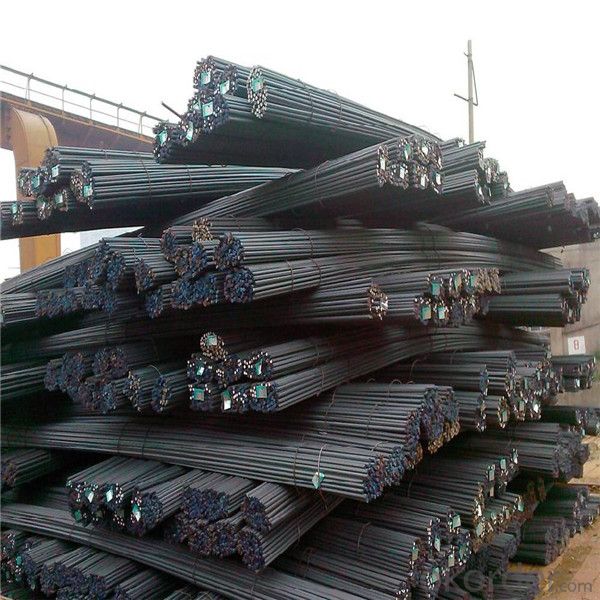
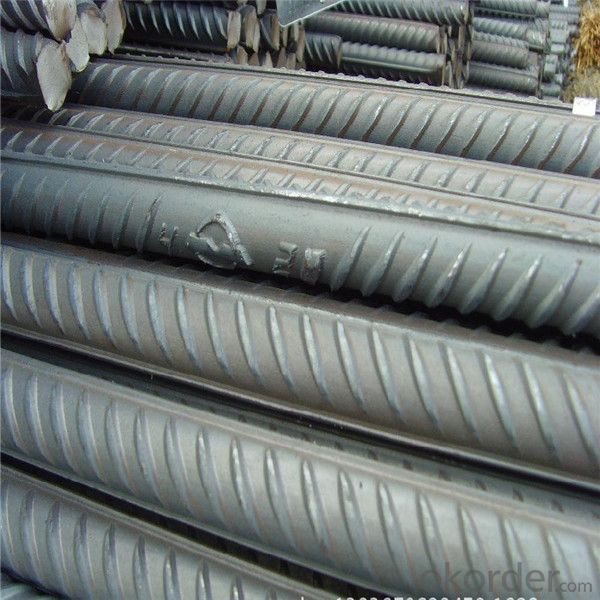
Packing:
In bundles, each bundle weight 3.5 tons. Load by container or by bulk verssel.
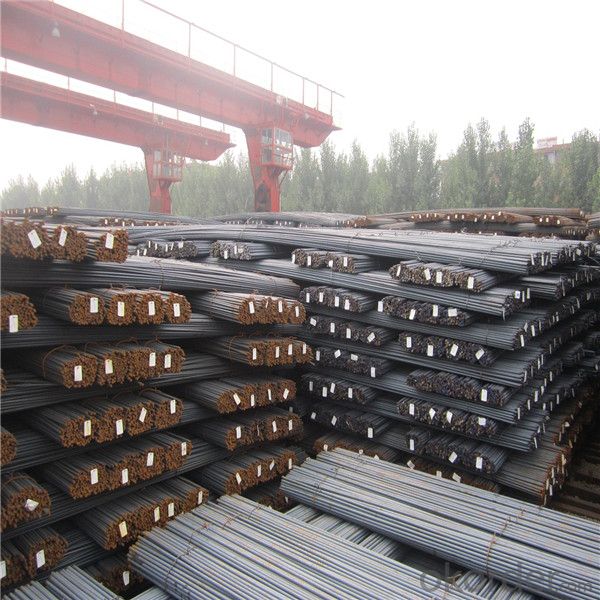
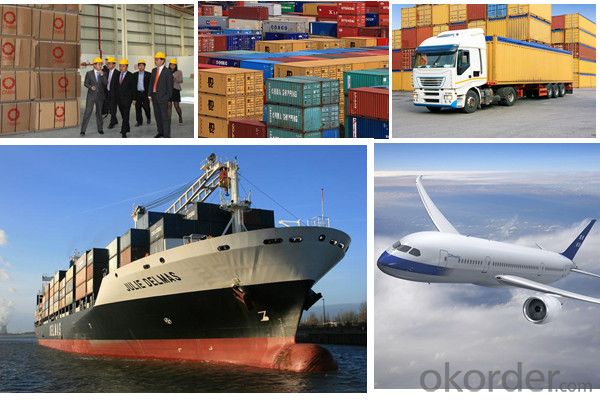
Our service
(1) We cooperate with famous factories with advanced equipment and well trained workers.
(2) We can provide factory price with trading company service.
(3) We continuously work on the improvement of our processes, guaranteeing consistently high standards
of quality to keep none compensation.
(4) We guarantee 24 hours response and 48 hours solution providing service.
(5) We accept small order quantity before formal cooperation.
(6) We deliver the agreed quality at the agreed time, reacting to changes in customer wishes in a flexible way.
(7) Due to our volume and selling power, we have excellent freight rates with shipping lines.
(8) We strive to always be fair and honest in our dealings with customers.
(9) We strive to work together with customers to achieve much more than we can achieve alone.
(10) Through our passion and commitment we aim to be a market leader in all our key markets. To maintain
our position as market leader we must continue to add value in all that we do.
FAQ:
1.Q: What's your MOQ(minimum order quantity)?
A: One full container, mixed acceptable .
2. Q: What's your packing methods?
A: Packed in bundle or bulk ..
3. Q: How can I buy CNBM products in my country?
A:Please send us an inquiry or email ,we will reply to you if there is distributor in your country
4. Q: Can we visit your factory?
A: Warmly welcome. Once we have your schedule, we will arrange the professional sales team to follow up your case.
5. Q: How long does it take to get the product if i place an order?
A:With the process of your requirements,we will pack and deliver in 3-7 days. If it is by sea shipment,it will take 15-45 days depending on different locations
- Q: Are steel rebars suitable for reinforcement in parking garages?
- Yes, steel rebars are highly suitable for reinforcement in parking garages. Steel rebars provide excellent structural integrity, durability, and resistance to corrosion, making them an ideal choice for reinforcing concrete structures like parking garages. Their high tensile strength helps absorb the stress and load-bearing requirements of the parking garage, ensuring its long-term stability and safety.
- Q: Can steel rebars be used in the construction of hospitals and healthcare facilities?
- Yes, steel rebars can be used in the construction of hospitals and healthcare facilities. Steel rebars provide structural integrity and strength to the buildings, ensuring their safety and durability. Additionally, steel rebars are resistant to fire, moisture, and corrosion, making them suitable for healthcare facilities that require high standards of cleanliness and hygiene.
- Q: Can steel rebars be replaced with other reinforcement materials?
- Yes, steel rebars can be replaced with other reinforcement materials. While steel rebars have been widely used in construction for their strength and durability, alternative materials have been developed that offer similar or even improved properties. One such alternative is fiber-reinforced polymer (FRP) bars, which are made of high-strength fibers embedded in a polymer matrix. FRP bars are lightweight, corrosion-resistant, and have a high tensile strength, making them an attractive replacement for steel rebars. They are also non-conductive and non-magnetic, making them suitable for use in areas with electromagnetic interference or in sensitive industries such as electronics. Another alternative is carbon fiber reinforced polymer (CFRP) bars, which are similar to FRP bars but are specifically reinforced with carbon fibers. CFRP bars offer even higher tensile strength and stiffness compared to steel rebars, making them particularly suitable for structures that require exceptional load-bearing capabilities. Furthermore, natural fiber reinforced composites (NFRC) have also been explored as a replacement for steel rebars. NFRC can be made from materials such as bamboo, jute, or sisal fibers embedded in a matrix material like cement or polymer. These natural fibers offer good tensile strength and can be a sustainable and cost-effective alternative to steel rebars, especially in regions where these fibers are abundantly available. In conclusion, while steel rebars have been the traditional choice for reinforcement materials in construction, alternatives such as FRP bars, CFRP bars, and NFRC can be viable substitutes. The choice of reinforcement material depends on various factors such as structural requirements, environmental conditions, and cost-effectiveness.
- Q: What are the common problems associated with steel rebars in construction?
- Some common problems associated with steel rebars in construction include corrosion, improper placement or spacing, inadequate cover, poor welding or splicing, and lack of proper anchorage.
- Q: Can steel rebars be used in swimming pools and water tanks?
- Yes, steel rebars can be used in swimming pools and water tanks. Steel rebars are commonly used as reinforcement in these structures to provide additional strength and stability. The rebars are typically placed within the concrete or masonry walls of the pool or tank during construction. Steel rebars are highly durable and resistant to corrosion, making them an ideal choice for these applications where they will be constantly exposed to water. Additionally, the use of steel rebars helps to prevent cracking and improve the overall structural integrity of the pool or tank.
- Q: How do steel rebars contribute to the overall safety of a structure?
- Steel rebars contribute to the overall safety of a structure by providing reinforcement and strength to concrete. They enhance the structural integrity, preventing cracking and failure under heavy loads or during seismic events. Steel rebars also help to distribute and absorb forces, improving the resistance against bending, shearing, and tension. By effectively reinforcing the concrete, steel rebars ensure the durability and longevity of the structure, minimizing the risk of collapse and ensuring the safety of occupants.
- Q: Are there any codes or regulations for the use of steel rebars in construction?
- Steel rebars in construction are subject to codes and regulations to ensure their proper use. Guidelines and standards are provided by organizations like the American Concrete Institute (ACI) in the United States. The ACI 318 Building Code Requirements for Structural Concrete outlines specific requirements for the size, placement, and quality of rebars. Similar regulations can be found in the widely adopted International Building Code (IBC), which governs construction practices in different jurisdictions. It includes provisions and references to standards that dictate the use of rebars in reinforced concrete structures. Different countries also have their own standards organizations, such as the British Standards Institution (BSI) in the United Kingdom. These organizations have their own codes and regulations for the use of rebars in construction. These codes and regulations are crucial for ensuring the safety and longevity of structures. They establish requirements for rebars' size, grade, and placement, as well as provide guidelines for designing, detailing, and constructing reinforced concrete elements. Adhering to these codes and regulations guarantees that structures can withstand anticipated loads and perform as intended.
- Q: Are steel rebars suitable for use in high-traffic areas like bridges?
- Yes, steel rebars are suitable for use in high-traffic areas like bridges. Steel rebars provide exceptional strength and durability, making them ideal for withstanding heavy loads and frequent use. Additionally, steel rebars offer excellent resistance to corrosion, ensuring the longevity and structural integrity of bridges in high-traffic areas.
- Q: How do steel rebars impact the overall constructability and scheduling of concrete projects?
- Steel rebars have a significant impact on the overall constructability and scheduling of concrete projects. They provide structural reinforcement to concrete, increasing its strength and durability. The inclusion of rebars in the concrete design requires careful planning and coordination, as they need to be accurately positioned and supported within the concrete forms. This process can add complexity to the construction process, potentially affecting the project's timeline. However, rebars ultimately enhance the project's constructability by ensuring the structural integrity of the concrete elements, leading to safer and more reliable structures.
- Q: How are steel rebars used in pre-stressed concrete structures?
- Steel rebars are used in pre-stressed concrete structures primarily to provide tensile strength and reinforcement. These rebars are strategically placed within the concrete to resist and distribute the forces acting on the structure. They are pre-stressed or tensioned before the concrete is poured, allowing them to counteract potential cracks and improve the overall structural integrity.
Send your message to us
Material steel rebar high quality from China
- Loading Port:
- Guangzhou
- Payment Terms:
- TT OR LC
- Min Order Qty:
- 100 m.t.
- Supply Capability:
- 19000 m.t./month
OKorder Service Pledge
OKorder Financial Service
Similar products
Hot products
Hot Searches
Related keywords


